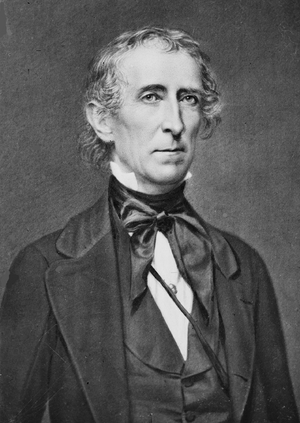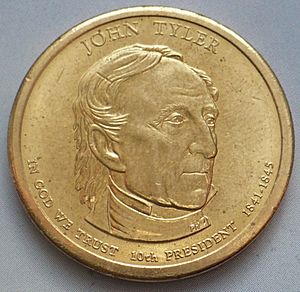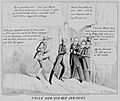John Tyler facts for kids
Quick facts for kids
John Tyler
|
|
|---|---|
 |
|
| 10th President of the United States | |
| In office April 4, 1841 – March 4, 1845 |
|
| Vice President | none |
| Preceded by | William Henry Harrison |
| Succeeded by | James Knox Polk |
| 10th Vice President of the United States | |
| In office 4 March 1841 – 4 April 1841 |
|
| President | William Henry Harrison |
| Preceded by | Richard Mentor Johnson |
| Succeeded by | George M. Dallas |
| President pro tempore of the Senate | |
| In office March 4, 1835 – December 4, 1835 |
|
| President | Andrew Jackson |
| Preceded by | George Poindexter |
| Succeeded by | William King |
| United States Senator from Virginia |
|
| In office March 4, 1827 – February 29, 1836 |
|
| Preceded by | John Randolph |
| Succeeded by | William Rives |
| 23rd Governor of Virginia | |
| In office December 10, 1825 – March 4, 1827 |
|
| Preceded by | James Pleasants |
| Succeeded by | William Giles |
| Member of the U.S. House of Representatives from Virginia's 23rd district |
|
| In office December 17, 1816 – March 5, 1821 |
|
| Preceded by | John Clopton |
| Succeeded by | Andrew Stevenson |
| Member of the Confederate States House of Representatives from Virginia's 1st Congressional District | |
| In office 1862–1862 |
|
| Preceded by | none |
| Succeeded by | James Lyons |
| Personal details | |
| Born | March 29, 1790 Charles City County, Virginia, U.S.A. |
| Died | January 18, 1862 (aged 71) Richmond, Virginia, C.S.A. |
| Nationality | American |
| Political party | Whig and none |
| Spouses | Letitia Christian Tyler (1st wife) Julia Gardiner Tyler (2nd wife) |
| Signature | |
John Tyler (born March 29, 1790 – died January 18, 1862) was the 10th President of the United States. He served from 1841 to 1845. He was the first Vice President of the United States to become president because the president before him died. Tyler was also the first president born after the Constitution of the United States was approved.
Contents
Early Life and Political Beginnings
Tyler grew up in Virginia and later became a lawyer. His father was also a lawyer who became the governor of Virginia. John Tyler followed in his father's footsteps. He became a state representative in the United States Congress. Then, he also served as the governor of Virginia.
Tyler started his political career with the Democratic Party. But he later joined the Whig Party, which was a newer political group. He was chosen to run as vice president alongside William Henry Harrison. Their campaign slogan was "Tippecanoe and Tyler Too." This slogan helped them win the election. William Henry Harrison was famous for a battle at a place called Tippecanoe.
Harrison and Tyler won the election. However, President Harrison died just one month after taking office. This meant that John Tyler became the new president.
John Tyler's Presidency
When Tyler became president, some people questioned if he was truly the rightful president. This was because he had not been elected to the top job. But the Constitution of the United States says that the vice president takes over if the president dies. Tyler insisted he was the new president, and the government agreed. Still, many in the Whig Party were unhappy. They often called him "the accidental president."
Tyler angered the Whig Party when he chose people from the Democratic Party to work in his government. He wanted to bring the two parties together. Instead, this made him unpopular with his own party. He disagreed with many of the Whigs' ideas. Because of this, the Whig Party decided not to choose him to run for president again in 1844.
During his time as president, Florida officially became a new state. Also, Texas was its own country after winning a war against Mexico. Tyler wanted Texas to join the U.S. and worked hard to make it happen. Texas became a U.S. state a few months after his presidency ended.
Later Years and the Civil War
The Whig Party did not support Tyler for president again in 1844. He had some friends in the Democratic Party, but they also did not want him as president. Tyler was sometimes called "the President without a party" because neither major group fully supported him.
When the Confederate States of America was formed, Tyler believed that states should have the right to make their own laws. He did not want a civil war to break out. He tried to get the United States to agree to let the southern states decide on important issues for themselves. But the United States Congress said no. Tyler then decided that his home state, Virginia, should join the Confederacy. He was later elected to the Confederate congress, but he passed away before he could start that job.
Death and Burial
John Tyler often had poor health throughout his life. As he grew older, he frequently caught colds in the winter. On January 12, 1862, he felt chills and dizziness. He then collapsed. Even with medical care, his health did not get better. He planned to return home by January 18. The night before, he began to struggle with breathing. His doctor was called. Just after midnight, Tyler took a sip of brandy and told his doctor, "I am going. Perhaps it is best." He died soon after, likely from a stroke.
Tyler's death was unique in presidential history. It was not officially recognized in Washington, D.C. This was because he had supported the Confederacy. He had asked for a simple burial. However, Confederate President Jefferson Davis planned a large, public funeral. Davis presented Tyler as a hero to the new Confederate nation. Because of this, the coffin of the tenth U.S. president was covered with a Confederate flag. He is the only U.S. president buried under a flag that was not the U.S. flag.
Tyler was buried in Hollywood Cemetery in Richmond, Virginia. His grave is near that of former President James Monroe. Several places in the U.S. are named after Tyler. This includes the city of Tyler, Texas. It was named for him because of his efforts to bring Texas into the United States.
John Tyler's Legacy
Historians have different opinions about John Tyler's presidency. Many historians generally see his time in office as not very successful. Some writers have called him a president who struggled and whose time in office had many problems. It has been noted that his presidency is often ranked as one of the least successful. He is not seen as a great president or a great thinker. A survey of historians in 2017 ranked Tyler as 39th out of 43 presidents.
While experts have both praised and criticized Tyler, most Americans do not know much about him. Many writers have said that Tyler is one of the most forgotten presidents. As one historian said, "His countrymen generally remember him, if they have heard of him at all, as the rhyming end of a catchy campaign slogan."
Images for kids
-
1888 illustration of President Tyler receiving the news of President Harrison's death from Chief Clerk of the State Department Fletcher Webster
-
Official portrait of President Tyler by George Peter Alexander Healy, c. 1864
-
Whig cartoon showing the effects of unemployment on a family with Jackson's and Van Buren's portraits
-
The borders of the United States and nearby nations in 1843. The Webster–Ashburton Treaty set the border of Maine. The Republic of Texas had a disputed border with Mexico.
-
A cartoon making fun of Tyler's efforts to get a second term. Tyler closes the door on opponents Clay, Polk, Calhoun, and Jackson, as Uncle Sam tells him to let Clay in.
-
An oil portrait of Tyler's first wife, Letitia Christian Tyler, by an unknown artist
-
Tyler on a U.S. postage stamp, Issue of 1938
See also
 In Spanish: John Tyler para niños
In Spanish: John Tyler para niños














